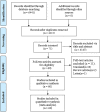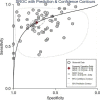Predictive validity of the braden scale for pressure injury risk assessment in adults: A systematic review and meta-analysis
- PMID: 33630407
- PMCID: PMC8363405
- DOI: 10.1002/nop2.792
Predictive validity of the braden scale for pressure injury risk assessment in adults: A systematic review and meta-analysis
Abstract
Aim: Pressure injuries are common adverse events in clinical practice, affecting the well-being of patients and causing considerable financial burden to healthcare systems. It is therefore essential to use reliable assessment tools to identify pressure injuries for early prevention. The Braden Scale is a widely used tool to assess pressure injury risk, but the literature is currently lacking in determining its accuracy. This study aimed to evaluate the accuracy of the Braden Scale in assessing pressure injury risk.
Design: Systematic review and meta-analysis.
Methods: Articles published between 1973-2020 from periodicals indexed in the PubMed, EMBASE, CINAHL, Web of Science and the Cochrane Library were selected. Two reviewers independently selected the relevant studies for inclusion. Data were analysed by the STATA 15.0 and the RevMan 5.3 software.
Results: In total, 60 studies involving 49,326 individuals were eligible for this meta-analysis. The pooled SEN, SPE, PLR, NLR, DOR and AUC were 0.78 (95% CI: 0.74 to 0.82), 0.72 (95% CI: 0.66 to 0.78), 2.80 (95% CI: 2.30 to 3.50), 0.30 (95% CI: 0.26 to 0.35), 9.00 (95% CI: 7.00 to 13.00) and 0.82 (95% CI: 0.79 to 0.85), respectively. Subgroup analyses indicated that the AUC was higher for prospective design (0.84, 95% CI: 0.81 to 0.87), mean age <60 years (0.87, 95% CI: 0.84 to 0.90), hospital (0.82, 95% CI: 0.79 to 0.86) and Caucasian population (0.86, 95% CI: 0.82 to 0.88). In addition, 18 was found to be the optimal cut-off value.
Conclusion: The evidence indicated that the Braden Scale had a moderate predictive validity. It was more suitable for mean age <60 years, hospitalized patients and the Caucasian population, and the cut-off value of 18 might be used for the risk assessment of pressure injuries in clinical practice. However, due to the different cut-off values used among included studies, the results had a significant heterogeneity. Future studies should explore the optimal cut-off value in the same clinical environment.
Keywords: pressure ulcer; risk assessment; sensitivity and specificity; systematic review.
© 2021 The Authors. Nursing Open published by John Wiley & Sons Ltd.
Conflict of interest statement
The authors declare no conflict of interest.
Figures






Similar articles
-
Home treatment for mental health problems: a systematic review.Health Technol Assess. 2001;5(15):1-139. doi: 10.3310/hta5150. Health Technol Assess. 2001. PMID: 11532236
-
The measurement and monitoring of surgical adverse events.Health Technol Assess. 2001;5(22):1-194. doi: 10.3310/hta5220. Health Technol Assess. 2001. PMID: 11532239
-
Eliciting adverse effects data from participants in clinical trials.Cochrane Database Syst Rev. 2018 Jan 16;1(1):MR000039. doi: 10.1002/14651858.MR000039.pub2. Cochrane Database Syst Rev. 2018. PMID: 29372930 Free PMC article.
-
Sertindole for schizophrenia.Cochrane Database Syst Rev. 2005 Jul 20;2005(3):CD001715. doi: 10.1002/14651858.CD001715.pub2. Cochrane Database Syst Rev. 2005. PMID: 16034864 Free PMC article.
-
Negative pressure wound therapy for open traumatic wounds.Cochrane Database Syst Rev. 2018 Jul 3;7(7):CD012522. doi: 10.1002/14651858.CD012522.pub2. Cochrane Database Syst Rev. 2018. PMID: 29969521 Free PMC article.
Cited by
-
Nutritional Support in the Prevention and Treatment of Pressure Ulcers in Healthy Aging: A Systematic Review of Nursing Interventions in Community Care.Geriatrics (Basel). 2025 Jan 22;10(1):17. doi: 10.3390/geriatrics10010017. Geriatrics (Basel). 2025. PMID: 39997516 Free PMC article. Review.
-
Nursing workload: use of artificial intelligence to develop a classifier model.Rev Lat Am Enfermagem. 2024 Jul 5;32:e4239. doi: 10.1590/1518-8345.7131.4239. eCollection 2024. Rev Lat Am Enfermagem. 2024. PMID: 38985046 Free PMC article.
-
The impact of a risk assessment tool on hospital pressure injury prevalence and prevention: a quantitative pre-post evaluation.Int J Nurs Stud Adv. 2025 May 1;8:100342. doi: 10.1016/j.ijnsa.2025.100342. eCollection 2025 Jun. Int J Nurs Stud Adv. 2025. PMID: 40415953 Free PMC article.
-
Development and validation of a nomogram for predicting the risk of pressure injury in adult patients undergoing abdominal surgery.Int J Nurs Sci. 2022 Sep 24;9(4):438-444. doi: 10.1016/j.ijnss.2022.09.010. eCollection 2022 Oct. Int J Nurs Sci. 2022. PMID: 36285073 Free PMC article.
-
An Integrated System of Multifaceted Machine Learning Models to Predict If and When Hospital-Acquired Pressure Injuries (Bedsores) Occur.Int J Environ Res Public Health. 2023 Jan 1;20(1):828. doi: 10.3390/ijerph20010828. Int J Environ Res Public Health. 2023. PMID: 36613150 Free PMC article.
References
-
- Al Mutairi, K. B., & Hendrie, D. (2018). Global incidence and prevalence of pressure injuries in public hospitals: A systematic review. Wound Medicine, 22, 23–31. 10.1016/j.wndm.2018.05.004 - DOI
-
- Aloweni, F., Ang, S. Y., Fook‐Chong, S., Agus, N., Yong, P., Goh, M. M., Tucker‐Kellogg, L., & Soh, R. C. (2019). A prediction tool for hospital‐acquired pressure ulcers among surgical patients: Surgical pressure ulcer risk score. International Wound Journal, 16(1), 164–175. 10.1111/iwj.13007 - DOI - PMC - PubMed
-
- Barnes, D., & Payton, R. G. (1993). Clinical application of the Braden Scale in the acute‐care setting. Dermatology Nursing, 5(5), 386–388. - PubMed
Publication types
MeSH terms
LinkOut - more resources
Full Text Sources
Other Literature Sources
Medical

